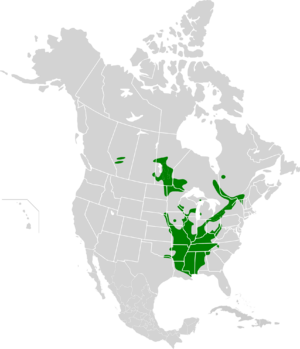Mooneye facts for kids
Quick facts for kids Mooneye |
|
|---|---|
 |
|
| Conservation status | |
| Scientific classification | |
 |
|
| Mooneye range in green | |
| Synonyms | |
|
The mooneye (scientific name: Hiodon tergisus) is a cool freshwater fish. It lives in rivers and lakes across eastern North America. This fish gets its name from its large, silvery eyes. It's known for its shiny body and flat shape.
Contents
Mooneye Appearance and Size
The mooneye has a bright, silvery look. Its body is quite flat from side to side. It also has a special ridge, called a keel, that runs along its belly. This keel goes from its anal fin to its pelvic fin.
Adult mooneyes are usually about 29.8 centimeters (11.7 inches) long. Some can grow up to 45 centimeters (17.7 inches) long. They typically weigh around 226 grams (8 ounces).
Where Mooneyes Live
Mooneyes are found only in eastern North America. Their range stretches from the Hudson Bay in the north. It goes all the way down to the Mississippi delta in the south. You can find them as far west as central Alberta, Canada. They also live as far east as western North Carolina.
Historically, mooneyes lived in most of the Great Lakes. This includes all but Lake Superior. However, their numbers have been dropping in Lake Michigan and Lake Erie. They used to live in smaller rivers too. Now, they are mostly found in larger rivers.
Why might their homes be changing? Building dams can block fish from moving between rivers. Things like climate change and pollution might also affect where they live.
Mooneye Habits and Diet
Mooneyes prefer clear rivers and lakes. They don't do well in muddy water. These fish are usually active during the day. They often feed near the water's surface.
Their main diet includes insects that live in water or fall into it. They also eat small crustaceans (like tiny shrimp) and mollusks (like snails). Sometimes, they even eat smaller fish.
Young mooneyes eat different things. They tend to feed closer to the bottom of the water. Their diet includes young caddisflies, mayflies, and midges.
Adult mooneyes don't have many known predators. But young mooneyes can be eaten by bigger fish.
Mooneye Life Cycle
Mooneyes lay their eggs in the spring. This is called spawning. Since they live in many different places, the timing changes. Southern mooneyes spawn in March and April. Northern mooneyes spawn later, in June and July.
Each spring, adult mooneyes swim upstream. They look for clear water to lay their eggs. A female mooneye can lay between 10,000 and 20,000 eggs each year. They like to lay eggs in clear, flowing water. They also prefer solid surfaces, like rocks, for their eggs.
When they first hatch, baby mooneyes are very tiny. They are only about 8 to 9 millimeters (0.3 inches) long. They mostly live in the open water. In their first few months, they eat young mayflies, caddisflies, and midges.
Mooneyes grow very quickly in their first year. They can reach up to 20 centimeters (7.9 inches) long. Females are ready to have babies when they are four or five years old. Males are ready at three years old. They will keep spawning every year after that. Males can live up to seven years. Females can live even longer, up to nine years.
Protecting Mooneyes
Currently, the mooneye is listed as a threatened species in New York, North Carolina, and Michigan. Even though they live in many places, their populations can be spread out. If a group of mooneyes disappears, it's hard for new fish to move in.
Pollution from farms and factories also harms their water quality. Mooneyes and other fish that don't like pollution have moved north. This is especially true in the Ohio River.
Dams are another big problem for mooneyes. Dams block their migration routes. This stops them from moving to different parts of rivers.
Right now, there are no specific programs just for protecting mooneyes.


